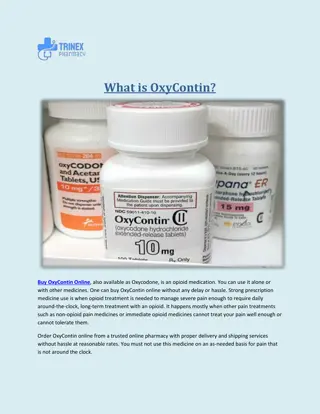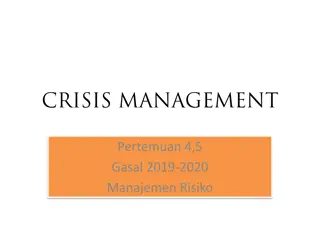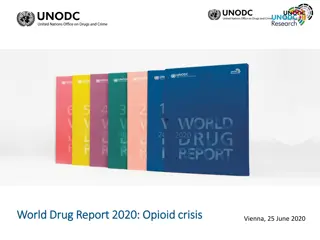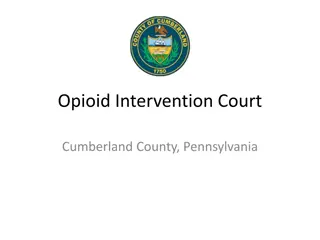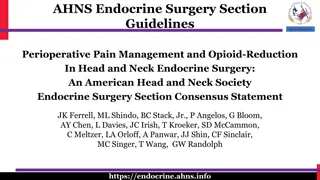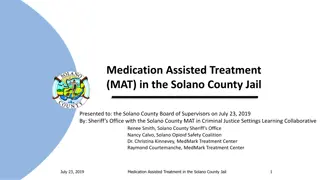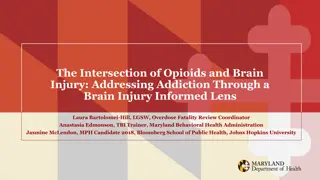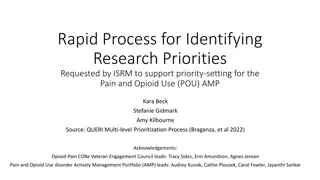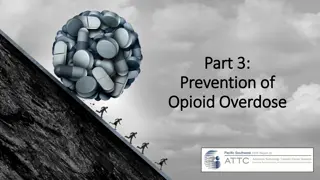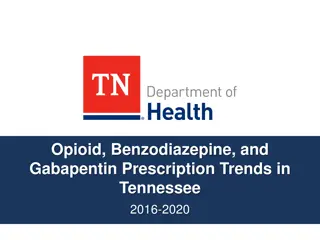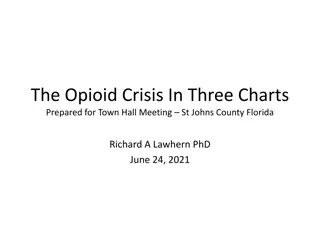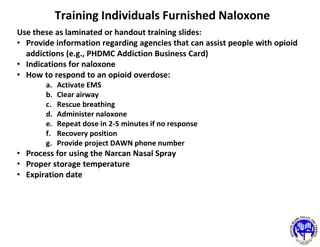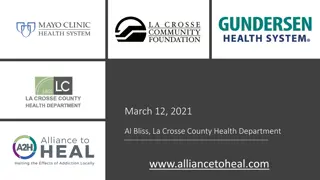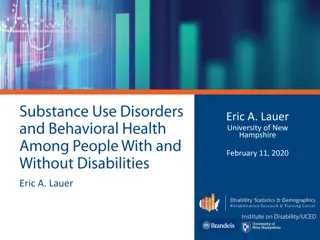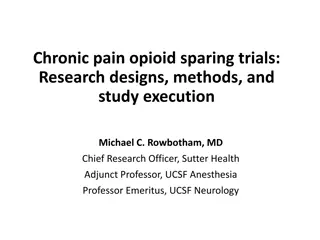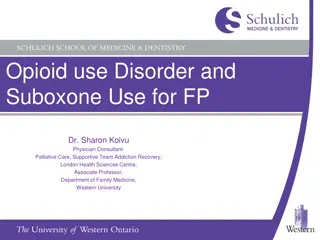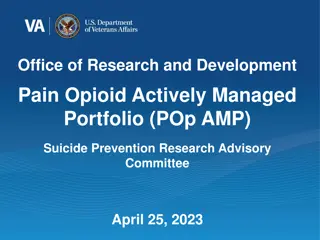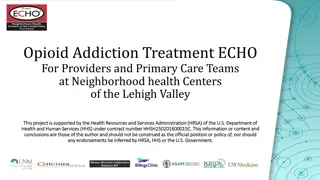The Opioid Crisis in the OH, KY, IN Tri-State Area Research Study
This research study delves into the impact of the opioid crisis in the Ohio, Kentucky, Indiana tri-state area from 1999-2016. The study analyzed total deaths and crude death rates related to opioids, urbanization levels, unemployment rates, and high school graduation percentages at the county level. The goal was to determine how state residency and urbanization levels influence opioid-related deaths, education, and poverty rates. Recommendations for opioid abuse prevention were formulated based on the findings.
Download Presentation

Please find below an Image/Link to download the presentation.
The content on the website is provided AS IS for your information and personal use only. It may not be sold, licensed, or shared on other websites without obtaining consent from the author. Download presentation by click this link. If you encounter any issues during the download, it is possible that the publisher has removed the file from their server.
E N D
Presentation Transcript
The Opioid Crisis in the OH, KY, IN Tri-State Area Lizzy Compton, Jacob Englert, Parker Kain, Sammi Shaw, Courtney Taylor
Background Information Total Number of Deaths from Opioids per County Crude Rate of Death from Opioids per County According to the CDC, from 1999-2016, more than 350,000 people died from an overdose involving some type of opioid. From 2015-2016 Ohio, Indiana, and Kentucky all saw increases in drug overdoses At Northern Kentucky University around 70% of enrolled students are residents of Indiana, Kentucky or Ohio. Because a high percent of our university calls this area home, we narrowed our research to the Tri-State area. We suspect that some of our conclusions/recommendations are generalizable to other parts of the United States.
Urbanization Levels: Large central metro Counties in metropolitan statistical areas of 1 million or more population that: Contain the entire population of the largest principal city Have their entire population contained in the largest principal city Contain at least 250,000 inhabitants of any principal city Large fringe metro Counties of 1 million or more population that did not qualify as large central metro counties. Medium metro Counties of populations of 250,000 to 999,999. Small metro Counties of populations less than 250,000. Micropolitan Counties in micropolitan statistical areas that have a population of at least 10,000 but less than 50,000. Noncore Nonmetropolitan counties that did not qualify as micropolitan. Our Data Total Number of Deaths from Opioids per County Crude Rate of Death from Opioids per County Urbanization Levels Using datasets available on the CDC webpage, we pulled data pertaining to all opioid related deaths in the Tri-State by county within state from 1999-2016. We compared both the total number of deaths and the crude rate of deaths (the total number of deaths the total population of each county). Because crude rate is more comparable across counties, we will be using those values in our analysis. We also pulled the Urbanization level for each county, with the hope of comparing deaths across these levels.
Poverty and Education Crude Rate of Death from Opioids per County In addition to the data from the CDC, we also pulled county level data from The United States Department of Agriculture. These datasets gave us the unemployment rates for each county (as of 2017) as well as the percentage of citizens who did not graduate high school in each county(2012 - 2016).
Goals and Methods Goals: Methods: Determine if state residency and/or the level of Urbanization affects the crude rate of deaths due to opioids. Compare the unemployment rates and the average percentage of citizens who did not graduate high school to State and Urbanization levels across counties to see how they are related. Create recommendations for opioid abuse prevention. SAS was used to merge and clean datasets. ANOVA models were developed to estimate the association between State and Urbanization levels and crude death rate, education, and poverty. Utilized Tukey Pairwise 95% confidence intervals to compare the mean crude death rate, education levels and poverty percentages across state and urbanization levels. Created visuals to represent our findings using Minitab and R software.
Results Crude Death Rate: Both State and Urbanization have a significant association to Crude Rate (State p-value<0.000, Urbanization p-value=0.028). By Tukey Pairwise Comparisons, the states are all significantly different from each other with Kentucky having the highest Crude Rate (mean=11.6490) followed by Ohio (mean=7.959), with Indiana having the lowest rate(mean=4.9863). For Urbanization, Noncore (Nonmetro) (mean=9.989) is significantly greater than Small Metro (mean=5.7202). Education: State (p-level<0.000) and Urbanization (p-level<0.000) both showed a significant association to the percentage of citizens who did not graduate high school in 2012 - 2016. Specifically, Kentucky (mean=18%) was significantly higher than both Ohio (mean=14%) and Indiana (mean=14%). Micropolitan and NonCore(Nonmetro) counties had significantly higher dropout rates compared to the Large Metro and Medium Metro counties. Unemployment Rates: State (p-level=0.007) and Urbanization (p-level<0.000) both showed significant association to the percentage of unemployed citizens between the years of 2012 and 2017. Specifically, Kentucky (mean = 7.42%) had a significantly higher unemployment rate than Indiana (mean = 6.68%). NonCore (nonmetro) counties had the highest mean unemployment rate across all counties.
Opioid Abuse Factors As the county unemployment rate increases by one percentage point, the opioid death rate per 100,000 rises by 0.19 (3.6%) (the National Bureau of Economic Research). Substance use was more likely among 12th grade aged dropouts than among those who were still in school, for example 12th grade aged dropouts were more likely to engage in nonmedical use of prescription- type drugs (9.5% vs. 4.6%) (the Substance Abuse and Mental Health Administration) Prevention programs can be designed to intervene as early as infancy to address risk factors for drug abuse (the National Institute on Drug Abuse). Based on these factors and our results from the previous slide we will focus our prevention efforts in three areas: Improving unemployment rates Enhancing prevention education (current education requirements are listed to the right) Focusing first on Nonmetro areas
Recommendations Education Because of the inconsistency in requirements, we recommend creating parallel education requirements across the states by: Increasing education to all grade levels Creating appropriate curriculum for each grade Implementing more detailed instructions and guidelines for each grade Prevention is most effective the earlier it starts so we believe that all states should be required to begin drug prevention education starting in kindergarten. Additionally, in order to ensure that school districts are sharing correct information and effectively presenting drug prevention resources, we propose that each state hire and train officials to instruct teachers how to develop these methods in their classroom. Secondly, part of each state s prevention efforts should be focused on decreasing dropout rates. The longer students are in the structured school environment, the less likely they are to abuse drugs. Unemployment Rates Since unemployment rate has a significant assosiation to opioid abuse and death, we believe that each state government should invest resources into creating new jobs. Urbanization We believe that states should prioritize their efforts and focus first on the Nonmetro counties as they are the ones currently with the worst death rate due to opioid abuse.
Conclusion Using data from the CDC as well as the Department of Agriculture, we concluded that both State and Urbanization level had a significant association to the crude rate of death due to opioids, the percentage of citizens who did not graduate high school, and the unemployment rates in each county within Ohio, Indiana and Kentucky. From these results we made recommendations to focus opioid abuse prevention methods around improving education, decreasing unemployment rates, and targeting specific urban areas first. We believe that these focal points could easily be expanded to the rest of the United States and be just as effective elsewhere.





